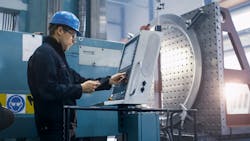Future interfaces and machine control need eyes to improve decisions
Eric Ostini is head of business development, North and Central America at GF Machining Solutions, whose international headquarters is in Biel/Bienne, Switzerland.
What have been the biggest improvements to operator-interface technology in the past five years?
Eric Ostini, head of business development, North and Central America, GF Machining Solutions: One example is track-and-trace software that collects real-time data from the machine to verify that the wire electrical discharge machine (EDM) is cutting correctly. A user can monitor 10 or 12 parameters/characteristics of successful wire cuts and set thresholds for the maximum amount of acceptable variation from them. That includes not only simple variations in part size, but also in part surface finish.
Also read: HMIs create a window of opportunity
Track-and-trace software will alert an operator to the problem. Parts that are produced within the set thresholds are considered to be good parts.
Critical applications that formerly required that every part be checked can now be checked every 15th or 50th part because the software monitors every cut and reports any variations from the preset thresholds.
Another example of innovative technology is an adaptation of Renishaw probe technology to wire EDM. The probe determines the part’s location prior to cutting it, thereby reducing setup time and assuring that the part will be in the proper position to be cut correctly. After the EDM operation, the probe measures cavities to confirm their accuracy before the part is removed from the machine.
What’s the most innovative or efficient operator-interface technology application you’ve ever seen or been involved with?
Eric Ostini, head of business development, North and Central America, GF Machining Solutions: Rapidly advancing Internet connectivity technology that enables a machine manufacturer’s service department to virtually visit an end user’s shop, connect with the machine control and accurately and efficiently diagnose a problem.
The manufacturer then can instruct the end user regarding actions that will fix the problem or, in some cases, download software updates that will do the job. If a physical service visit is still required, the technician will come prepared with an accurate diagnosis and have on hand procedures and/or parts to effect a repair. Some other distributive-numerical-control (DNC) software programs can function similarly but require complicated and time-consuming setup for each incident.
Also read: Membrane puts the human in HMI
Connective technology also enables machine operators or shop owners to check machine status at all hours from home or other off-site locations.
Can you explain how software development has changed operator interfaces in manufacturing?
Eric Ostini, head of business development, North and Central America, GF Machining Solutions: Advances in operating systems and software continually improve machine-control speed of operation and also provide the capabilities needed to handle new and complex machine functions.
Additionally, it is no surprise that manufacturing operator interfaces have benefited greatly from widespread and continuing advances in mobile-telephone software and technology. Beyond the basic keyboard and mouse, machine-control interfaces now enable touch technology including pinch-and-zoom, three-finger rotation and swiping to move from page to page, thereby providing intuitive operation and boosting speed.
How do operator-interface technologies figure into digital-twin platform models being used by manufacturers?
Eric Ostini, head of business development, North and Central America, GF Machining Solutions: Digital twins in manufacturing take two forms: data twins and image/solid-model twins. Operator-interface systems generally employ solid-model twins developed by computer-aided-design or –manufacturing (CAD/CAM) companies to pull in the images and create codes to output part-cutting programs.
Key to that process is visualization or simulation capabilities on the control that will confirm that the machine chosen to do the cutting has the structural and volumetric capacity to process the part.
When will operator interfaces become IT-friendly enough that engineers are no longer required for installation and operation?
Eric Ostini, head of business development, North and Central America, GF Machining Solutions: Machine manufacturers’ future connectivity packages will soon be able to recognize the software version possessed by an end user and be able to determine if that software can run a certain application. Then, if necessary, the package will tell the end user what upgrades are needed and be able to provide them over the air, either for trial, subscription or purchase, via automatic installs in the background.
Also in the future, cloud-based shop profiles will list all of a facility’s machines, report which have out-of-date software and offer options for software updates. Selective updating will enable a shop to choose the software it needs for the operations it regularly performs without including software for jobs it doesn’t or will never do.
Also read: Get back to physical interfaces
What future innovations will impact the use of operator-interface technology in manufacturing operations?
Eric Ostini, head of business development, North and Central America, GF Machining Solutions: Bar codes or QR codes on uncut workpieces provide huge amounts of information that until recently was processed on the control by the operator. As innovations continue, a QR-code scan will guide a robot to load the workpiece and position it in the machine. It will list initial machining points, such as wire start holes for EDM.
Track-and-trace software will monitor cutting operations and adjust machining parameters to maximize accuracy and efficiency. Sensing and probing technology will judge the acceptability of the final machined part, and a robot will remove it from the machine to be replaced by the next workpiece in line.
The following comments and analysis are my personal speculation and not based on any actual development or visions of GF Machining Systems.
Basically, the amount of human intervention in machining operations is shrinking. Every piece of the progression to truly unattended operation is available; it’s just a matter of putting the pieces together.
In the past 15 years, every control manufacturer has developed products intended to make their use easier for the operator. The recent pandemic-driven and economics-based shortage of skilled operators has accelerated that movement.
Major enhancements for machine-tool control will be based on visual assessment of what needs to be done in a manufacturing process. It has to go beyond optical sensing and Renishaw probes.
The machine control of the future needs to have its own set of eyes to make valid decisions based on the massive amount of information available. For example, a “smart” bar feeder could collect information about the bar length available during a process and relay that information to the machine control. The control could then match the information to production requirements, and/or search a library of future jobs to utilize the remaining stock in a prioritized and cost-efficient way.
Also read: Machine builder's customers bring new machining technologies to integrate into platforms
In another example, machine controls could monitor and store the maintenance status of all of a shop’s machines and shuffle output among them when breakdowns or maintenance needs dictate. A truly smart machine control could also vary production volume and timing in response to outside factors, such as peak- and off-peak electrical power costs.
The data are there, and these ideas are doable. Future machine controls will use these data to maximize future productivity and profits.
Tell us about your company’s state-of-the-art operator-interface technology for manufacturing.
Eric Ostini, head of business development, North and Central America, GF Machining Solutions: The present and future of operator-interface technology at GF Machining Systems is the Uniqua human-machine interface. Currently in use on GFMS wire electrical discharge machining (EDM), the Uniqua HMI will be introduced for the company’s die-sinking and laser products. It features the Windows 10 64-bit release of the Windows operating system, as well as Intel i5/i7 processors and a solid-state hard drive. The software and hardware together facilitate interfacing with application programming interfaces (APIs) and expedite communication between the unit and the PC, enabling graphic control similar to that of the iPhone system. The resulting responsiveness has permitted GFMS to develop advanced EDM systems, such as automatic slug welding and slug removal, iWire adaptive wire speed function, and Intelligent Spark Protection System (ISPS) that continually measures and adjusts the EDM spark between the upper and lower heads.
The Uniqua HMI also enables drive-system adaptability because the control is the master instead of the drive system. This frees the control to utilize different drive systems if drive component supplies or other considerations make that necessary.
About the Author
Mike Bacidore
Editor in Chief
Mike Bacidore is chief editor of Control Design and has been an integral part of the Endeavor Business Media editorial team since 2007. Previously, he was editorial director at Hughes Communications and a portfolio manager of the human resources and labor law areas at Wolters Kluwer. Bacidore holds a BA from the University of Illinois and an MBA from Lake Forest Graduate School of Management. He is an award-winning columnist, earning multiple regional and national awards from the American Society of Business Publication Editors. He may be reached at [email protected]

Leaders relevant to this article:


